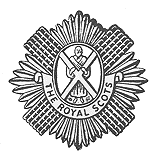
The Royal Scots,once known as the Royal Regiment of Foot,was the oldest and most senior infantry regiment of the line of the British Army,having been raised in 1633 during the reign of Charles I. The regiment existed continuously until 2006,when it amalgamated with the King's Own Scottish Borderers to become the Royal Scots Borderers,which merged with the Royal Highland Fusiliers,the Black Watch,the Highlanders and the Argyll and Sutherland Highlanders to form the Royal Regiment of Scotland.

General James Murray was a Scottish army officer and colonial administrator who served as the governor of Quebec from 1760 to 1768 and governor of Minorca from 1778 to 1782. Born in Ballencrieff,East Lothian,Murray travelled to North America and took part in the French and Indian War. After the conflict,his administration of the Province of Quebec was noted for its successes,being marked by positive relationships with French Canadians,who were reassured of the traditional rights and customs. Murray died in Battle,East Sussex in 1794.

The Royal Scots Fusiliers was a line infantry regiment of the British Army that existed from 1678 until 1959 when it was amalgamated with the Highland Light Infantry to form the Royal Highland Fusiliers which was later itself merged with the Royal Scots,King's Own Scottish Borderers,the Black Watch,the Argyll and Sutherland Highlanders and the Highlanders to form a new large regiment,the Royal Regiment of Scotland.

Schomberg Henry Kerr,9th Marquess of Lothian,,styled Lord Schomberg Kerr until 1870,was a British diplomat and Conservative politician. He served as Secretary for Scotland under Lord Salisbury between 1887 and 1892. He was usually styled simply as Lothian.
Lieutenant-General William Kerr,2nd Marquess of Lothian,was a Scottish peer who held a number of minor military and political offices. He was known by the courtesy title of Lord Newbattle until 1692,when he succeeded as Lord Jedburgh,then as Marquess of Lothian when his father died in 1703.

The Lothians and Border Horse was a Yeomanry regiment,part of the British Territorial Army. It was ranked 36th in the Yeomanry order of precedence and was based in the Scottish Lowland area,recruiting in the Lothians –East Lothian (Haddingtonshire),Midlothian (Edinburghshire),and West Lothian (Linlithgowshire) –and along the border with England,particularly Berwickshire. It amalgamated with the Lanarkshire Yeomanry and the Queen's Own Royal Glasgow Yeomanry to form the Queen's Own Lowland Yeomanry in 1956.

James Livingston,1st Earl of Callendar,was a Scottish army officer who fought on the Royalist side in the Wars of the Three Kingdoms.
Lieutenant General Sir Alistair Stuart Hastings Irwin,is a retired British Army officer and a former Adjutant-General to the Forces.
Queen's Birthday Honours are announced on or around the date of the Queen's Official Birthday in Australia,Canada,New Zealand and the United Kingdom. The dates vary,both from year to year and from country to country. All are published in supplements to the London Gazette and many are conferred by the monarch some time after the date of the announcement,particularly for those service people on active duty.
The New Year Honours 1973 were appointments in many of the Commonwealth realms of Queen Elizabeth II to various orders and honours to reward and highlight good works by citizens of those countries. They were announced on 1 January 1973 to celebrate the year passed and mark the beginning of 1973.
The 1949 King's Birthday Honours were appointments by many of the Commonwealth Realms of King George VI to various orders and honours to reward and highlight good works by citizens of those countries. The appointments were made "on the occasion of the Celebration of His Majesty's Birthday",and were published in supplements to the London Gazette of 3 June 1949 for the British Empire,New Zealand,India and Ceylon.
Events from the year 1794 in Scotland.
The 1915 Birthday Honours were appointments by King George V to various orders and honours to reward and highlight good works by citizens of the British Empire. The appointments were made to celebrate the official birthday of The King,and were published in The London Gazette and in The Times on 3 June 1915.
The 1918 Birthday Honours were appointments by King George V to various orders and honours to reward and highlight good works by citizens of the British Empire. The appointments were made to celebrate the official birthday of The King,3 June and were published in The London Gazette on the same day,followed by a supplement.
John Boswell was a Scotland international rugby union player. He was the 25th President of the Scottish Rugby Union. He served in the military in the Boer War and the First World War and won the Serbian medal Order of the White Eagle in 1917. He was a Writer to the Signet and owned Garallan House near Cumnock.
James Aikman Smith (1859-1931) was a Scottish rugby union player and later became an international referee. He became the 47th President of the Scottish Rugby Union.
The Queen's Edinburgh Light Infantry Militia was an auxiliary regiment raised in and around the city of Edinburgh in Scotland. It was formed in 1798 and reformed in 1802,but had links with earlier Fencible and Volunteer units from the area. It served in home defence during the Napoleonic Wars and the Crimean War. Later it became a battalion of the Royal Scots and saw active service in South Africa during the Second Boer War. It served as a Special Reserve training unit in World War I,but after 1921 the militia had only a shadowy existence until its final abolition in 1953.
Arthur Laing was a Scotland international rugby union player.
Sir Alexander Falconer Giles,KBE,CMG was a British colonial administrator.





